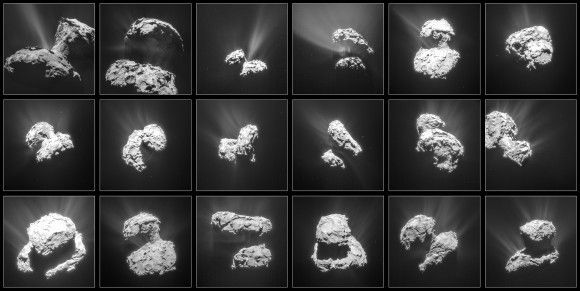Experience 2 months of Rosetta’s comet
Experience 2 months of Rosetta’s comet
Apr 15, 2015
by EarthSky in Photos » Science Wire, Space

This spectacular montage of 18 images shows off Comet 67P/Churyumov-Gerasimenko’s increasing activity from many different angles, as captured by ESA’s Rosetta spacecraft between January 31 (top left) and March 25 (bottom right), 2015. In these images, the spacecraft was at distances of about 30 to 100 kilometers from the comet, and the comet was at distances between 363 million and 300 million kilometers from the sun.
On August 13, 2015, Comet 67P/Churyumov-Gerasimenko will reach perihelion – its closest point to the sun. For 67P/Churyumov-Gerasimenko, this takes place at a distance of about 185 million kilometers from the sun, between the orbits of Earth and Mars. The Rosetta spacecraft is along for the ride, and has been watching the gradual evolution of the comet since arriving in August, 2014.
As the comet’s surface layers are gently warmed, frozen ices sublimate. The escaping gas carries streams of dust out into space, and together these slowly expand to create the comet’s fuzzy atmosphere, or coma.
As the comet continues to move closer to the sun, the warming continues and activity rises, and pressure from the solar wind causes some of the materials to stream out into long tails, one made of gas, the other of dust. The comet’s coma will eventually span tens of thousands of kilometres, while the tails may extend hundreds of thousands of kilometres, and both will be visible through large telescopes on Earth.
But it is Rosetta’s close study of the comet, from just a few tens of kilometers above its surface, which enables the source of the comet’s activity to be studied in great detail, providing context to the more distant ground-based observations.
More
http://earthsky.org/space/spectacular-images-show-2-months-of-rosettas-comet?utm_source=EarthSky+News&utm_campaign=9ee7cc05c8-EarthSky_News&utm_medium=email&utm_term=0_c643945d79-9ee7cc05c8-393525109
